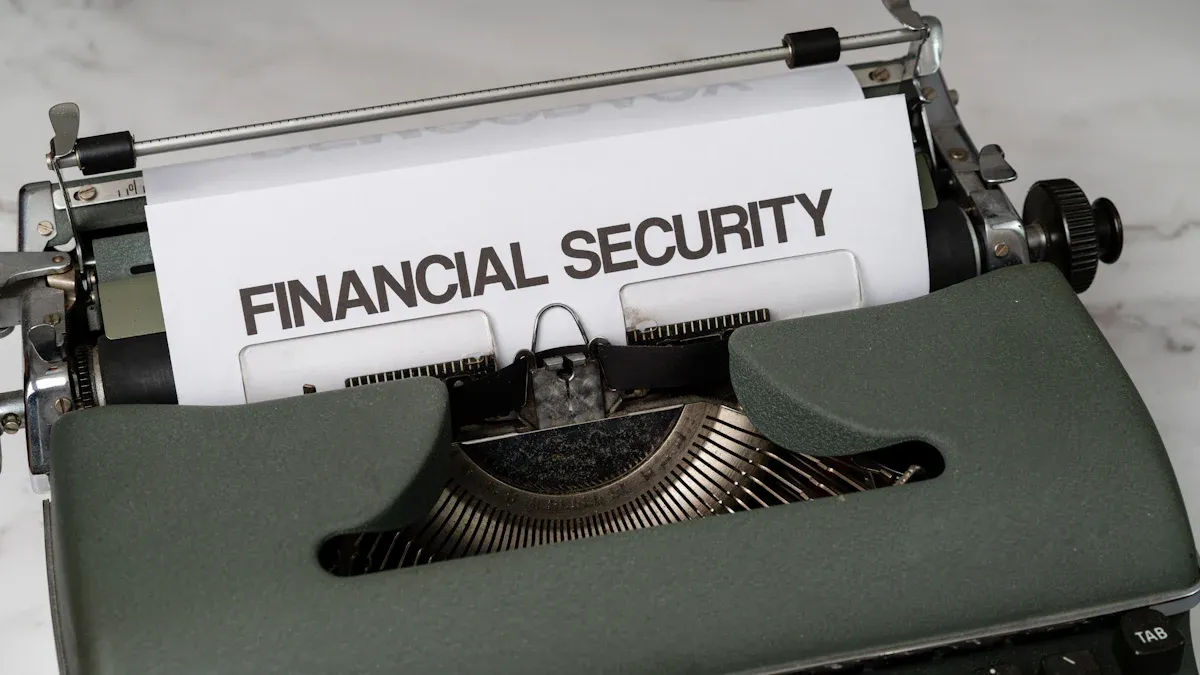- EasyCard
- Trade
- Help
- Announcement
- Academy
- SWIFT Code
- Iban Number
- Referral
- Customer Service
- Blog
- Creator
Latest Strategies for Bank Account Unfreezing and Prevention in 2025

Image Source: pexels
Having your bank account frozen can catch you off guard, but swift action can minimize losses. Statistics show that businesses often manage to unfreeze accounts quickly by keeping detailed transaction records and properly managing fund usage. For instance, a cross-border electronics e-commerce company resolved their freezing issue successfully by maintaining comprehensive transaction evidence and segregating funds.
To unfreeze your account promptly, you must understand the freezing reasons and take targeted measures. Causes may include suspicious transactions, identity issues, or even legal investigations. When dealing with large sums, a common question arises: how much money triggers bank scrutiny? This deserves careful attention.
Prevention is equally vital. Regularly reviewing your account transactions, maintaining communication with your bank, and updating identity information can effectively reduce the risk of freezing.
How to Quickly Unfreeze Your Bank Account?

Image Source: pexels
Initial Assessment of Freezing Types
When your bank account is frozen, your first step is to identify the freeze type, which helps target the right solution. Banks usually notify you by SMS or email with the freeze reason and an error code. Carefully review this info, note the code, and analyze the cause. Typical freeze types include:
- Suspicious transactions: Large or frequent transactions trigger risk controls.
- Identity issues: Expired or incomplete ID documents.
- Legal investigations: Account involved in legal cases or on investigation lists.
- Dormant or inactive accounts: Long inactivity or unusual logins.
Knowing the freeze type helps you prepare proper unfreeze documents. For example, if suspicious transactions cause the freeze, prepare proof of fund sources and transaction records. Confirm the specific steps with your bank’s customer service.
Key Steps to Contact Bank Customer Service
Communicating with your bank is critical for unfreezing. To improve efficiency:
- Call during peak availability (e.g., 9–11 AM).
- Clearly explain your freeze issue and provide the error code.
- Have ID, transaction logs, and fund proofs ready for verification.
- Use multiple communication channels—phone, online chat, or email appeals.
Banks often resolve issues faster when clients give detailed info. For example, after optimizing transfer processes, a bank increased satisfaction scores from 3.5 to 4.6 by proactively notifying complainants (source).
Important Notes When Submitting Materials
Ensure documents are complete and accurate:
- Verify ID validity, clear transaction records, and detailed fund source proofs.
- Comply with deadlines, e.g., tax filings often required between March 1 and June 30 following income year (source).
- Organize documents by category: identity, transactions, funds.
- Follow up regularly with the bank on review progress.
Tax authorities may prompt clarifications or interviews if anomalies appear. Promptly verifying undeclared amounts and organizing proofs can speed up bank reviews and shorten freeze duration.
Also, consider “how much money triggers bank scrutiny?” Banks monitor large transactions for legitimacy, so prepare detailed proofs when handling big amounts to avoid additional freezes.
Strategies While Waiting for Review
During bank review, act proactively to shorten wait and reduce risks:
1. Prioritize Fixing Key Issues
Focus on core problems, e.g., update ID if expired, provide source proofs for suspicious funds. Quick fixes can greatly reduce review time.
2. Appeal and Maintain Communication
Submit appeals with explanations and evidence. Stay in touch via phone or online channels. Follow up every few days politely.
3. Establish Long-Term Compliance Management
Use this time to improve account management:
- Monitor bank policies regularly.
- Use automated tools to detect risks like unusual trades or outdated ID.
- Keep transaction records organized.
4. Use Account Prudently
Avoid large or frequent trades during review to prevent triggering further controls.
5. Seek Professional Help if Needed
For complex cases (e.g., legal investigations), consult lawyers or compliance experts to ensure documents meet legal standards.
Real-Life Examples
- A cross-border e-commerce company quickly unfroze their account within two weeks after correcting transaction errors and submitting updates online (source).
- An investor resolved freeze after submitting fund proofs and repeated bank communications.
- A fintech company built an automated risk monitoring system preventing future freezes.
Such tactics help you handle bank reviews calmly and resume normal account use faster.
Common Reasons for Bank Account Freezes
Suspicious Transaction Behavior
Banks monitor account activity in real time and freeze accounts upon detecting suspicious behavior. Common triggers (source):
| Suspicious Activity | Trigger Rule |
|---|---|
| Large single transfers | Exceeding daily or per-transaction limits |
| Excessive small transfers | Aggregate over threshold within short time |
| Recipient on blacklist | Matches shared blacklists with police |
Frequent small transfers might flag money laundering risks. To avoid freezes, keep transactions legitimate with clear source and purpose. Remember that large sums attract bank scrutiny.
Incomplete or Expired Identity Information
Account freezes often arise from outdated or missing identity info. Examples:
- HR app under investigation for lacking data protection.
- Media app storing citizen info unencrypted.
- Marriage app missing clear data usage rules.
- Driver training app storing millions of personal records unencrypted.
These highlight the risk of poor identity management. Regularly verify and update your info to prevent freezes.
Legal or Judicial Investigations
Accounts may freeze due to involvement in investigations, e.g.:
- Suspected illegal activity like money laundering.
- Linked to ongoing cases.
- Account holder listed for judicial monitoring.
Cooperate actively by providing legal documents and proofs to speed unfreeze.
Long-Term Inactivity or Abnormal Logins
Dormant or irregular login activity may trigger freezes. Banks flag accounts without transactions or with suspicious multi-location logins.
Prevent by:
- Keeping account active with occasional transactions.
- Enabling two-factor authentication.
- Monitoring login history and reporting anomalies.
How Much Money Triggers Bank Scrutiny?
Banks apply risk management and regulatory rules, monitoring large or frequent transfers. Commonly, transactions above $10,000 (or equivalent) prompt review. Knowing these helps manage funds and reduce freeze risks.
| Evidence Type | Description |
|---|---|
| Comprehensive Risk Monitoring | Banks use tech to track all transactions and detect compliance risks in real time. |
| Continuous Improvement | Compliance teams adapt systems with AI to better identify risks. |
Practical Guide to Unfreezing Bank Accounts
Required Documents Checklist
Prepare the following for smooth review:
- Valid ID copies (passport or ID card).
- Detailed transaction history with amounts, dates, and recipients.
- Proof of fund sources (pay slips, contracts, invoices).
- Legal documents if freeze relates to judicial cases.
Organize files by type to help bank staff review efficiently.
Legal regulations specify required materials, e.g., urgent freeze lifting requires proof of legality (source).
Communication Tips with Banks
Clear, polite communication speeds resolution:
- Book appointments if possible.
- Briefly explain the freeze and provide documents.
- Keep records of calls, agent names, and advice.
- Submit additional materials promptly and confirm receipt.
Example: A user updated expired ID after a call and had account unfrozen in 3 days.
Legal Solutions for Complex Freezes
If legal involvement exists:
- Consult finance-law specialists.
- Submit legal proofs as advised.
- Apply for court orders if needed.
- Follow all legal procedures carefully.
Legal processes can take time but resolve tough freezes, as in a cross-border trade company’s month-long case.
Common Post-Unfreeze Issues
After unfreeze, issues may include:
1. Limited Account Functions
Banks might limit transfers or transaction frequency initially. Contact bank to request restoration, provide proofs as needed.
2. Balance Discrepancies
Unprocessed transactions or system updates may cause mismatches. Check records and confirm with bank.
3. Security Concerns
Change passwords, enable two-factor authentication, and monitor account activity for safety.
4. Compliance Checks
Banks may require extra identity or fund proof. Prepare documents and comply promptly.
Maintain account activity and avoid unusual behavior to reduce future freeze risks.
Effective Measures to Prevent Bank Account Freezes

Image Source: pexels
Regulate Transaction Behavior
Banks watch for suspicious patterns like frequent large inflows or irregular transactions. To avoid triggers:
- Keep all transactions transparent with valid contracts or invoices.
- Avoid rapid frequent small transfers which may look like money laundering.
- Avoid dealing with flagged or blacklisted accounts.
Judicial authorities recommend risk prevention to ensure healthy markets (source).
Regularly Update Personal Information
Accurate, current ID info is essential. Regularly check and renew documents, update contact details, and respond promptly to bank notifications.
| Legal Clause | Summary |
|---|---|
| New Law Article 45 | Temporary freezes max 48 hours; must be lifted if no further order within 48 hours. |
Financial institutions verify IDs via AML authorities, making updates vital to compliance.
Account Security Best Practices
Poor password management or compromised accounts risk triggering freezes. Recommendations:
- Use strong, complex passwords.
- Enable two-factor authentication.
- Change passwords every three months.
- Regularly monitor login and transaction records.
Financial institutions enforce anti-fraud measures and identity checks to protect accounts.
Monitor Account Activity
Active monitoring helps detect problems early:
1. Use Real-Time Monitoring Tools
Banks use AI and advanced systems to spot anomalies quickly (source).
| Evidence Type | Description |
|---|---|
| Real-Time Monitoring | AI-powered multi-dimensional early warnings and strategy optimization. |
| Financial Tech Reports | Integration of internal and external data for risk detection. |
| Risk Insight Analysis | Historical data analysis for credit risk evaluation. |
2. Check Transaction Records Regularly
Verify each transaction matches expectations. Classify and analyze records, watch for large or frequent small transactions.
3. Enable Transaction Alerts
Receive SMS, email, or app push notifications immediately when transactions occur.
4. Use Dynamic Risk Scoring
Systems generate risk scores based on behavior patterns to highlight potential threats.
5. Update Security Settings Periodically
Change passwords, enable 2FA, and monitor login history.
Future Trends: New Developments in Bank Account Management
Growth of Digital Banking Services
Digital banking is expanding globally, offering online account opening, mobile payments, and real-time transactions. Challenges include:
- Banks lacking digital marketing expertise.
- Marketing risks affecting service uptake.
- Poor platforms and confusing processes.
- Insufficient data analysis limiting precise targeting.
Banks increasingly use AI to personalize services, boosting satisfaction and competitiveness.
Tighter Account Regulations
Due to rising financial crime, stricter policies emerge worldwide. Banks monitor large transfers, often flagging over $10,000 for review to prevent fraud and protect funds.
Adapting to Future Requirements
Stay ahead by learning digital tools, enhancing security with 2FA and password rotation, monitoring policy changes, and organizing transaction records.
Some banks adopt blockchain-based management systems improving transparency and reducing manual checks.
Evolution of Secure Cross-Border Payment Technology: BiyaPay
As global account regulations tighten, blockchain-driven cross-border payment platforms are becoming an innovative solution to fund freezing challenges. Taking BiyaPay—a platform licensed in multiple countries—as an example, it enhances remittance security through a triple-layered mechanism:
- Intelligent Compliance Routing System
Automatically matches clearing channels compliant with the recipient country’s regulations (e.g., U.S. MSB license, Canada’s FINTRAC registration) to avoid freezes triggered by non-compliant payment routes. When users send money to the Philippines, the system prioritizes local partners holding e-money licenses in that country, reducing policy risks. - Real-Time Transaction Traceability Technology
Each transaction generates tamper-proof blockchain records (including the sender’s Singapore digital identity and the originating Australian account details), meeting anti-money laundering (AML) verification requirements from regulators like Germany’s BaFin and Japan’s FSA. - Dynamic Currency Conversion Guarantee
Supports conversions between 30+ fiat currencies and 200+ cryptocurrencies, displaying real-time local amounts for recipients (e.g., MYR for Malaysia, BRL for Brazil). When a user pays $5,000 USD, the system converts it at live exchange rates into the target country’s currency, preventing cross-border transfers from triggering risk controls due to currency conversion.
Understanding freeze causes and preparing complete documents—ID, transaction logs, fund proofs—while maintaining communication helps speed up unfreezing.
Preventive measures like transaction discipline, timely info updates, two-factor authentication, and real-time monitoring effectively reduce freeze risks.
With digitalization rising, embracing blockchain and AI tools boosts account security and management efficiency, giving you a global financial edge.
FAQ
1. How long does it take to unfreeze a bank account?
It depends on the cause and completeness of submitted materials. Typically 3-7 business days after full submission; longer if legal investigation involved. Keep in touch with your bank for updates.
2. How to find out why my account was frozen?
Banks usually notify by SMS or email with reasons and error codes. If not, proactively check account status and consult bank.
3. Can I withdraw money during a freeze?
Frozen accounts generally block withdrawals and transfers until resolution.
4. Can third parties speed up unfreezing?
Professional firms (lawyers, compliance consultants) may assist in complex cases but cannot guarantee faster approval.
5. Does freezing affect credit records?
Usually not directly, but illegal causes or failure to comply can harm credit scores. Resolve quickly to minimize risks.
*This article is provided for general information purposes and does not constitute legal, tax or other professional advice from BiyaPay or its subsidiaries and its affiliates, and it is not intended as a substitute for obtaining advice from a financial advisor or any other professional.
We make no representations, warranties or warranties, express or implied, as to the accuracy, completeness or timeliness of the contents of this publication.




Contact Us
Company and Team
BiyaPay Products
Customer Services
is a broker-dealer registered with the U.S. Securities and Exchange Commission (SEC) (No.: 802-127417), member of the Financial Industry Regulatory Authority (FINRA) (CRD: 325027), member of the Securities Investor Protection Corporation (SIPC), and regulated by FINRA and SEC.
registered with the US Financial Crimes Enforcement Network (FinCEN), as a Money Services Business (MSB), registration number: 31000218637349, and regulated by FinCEN.
registered as Financial Service Provider (FSP number: FSP1007221) in New Zealand, and is a member of the Financial Dispute Resolution Scheme, a New Zealand independent dispute resolution service provider.




















